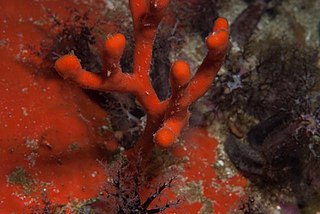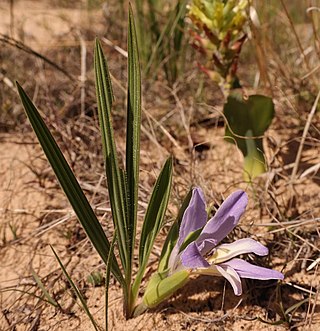
The grey wall sponge is a species of sea sponge belonging to the family Ancorinidae. It is found around the coast of Southern Africa from the Northern Cape to KwaZulu-Natal. It is an endemic species.

The orange wall sponge is a species of sea sponge belonging to the order Trachycladida. It is found in the south Atlantic and Indo-Pacific oceans. Around the South African coast, it is known from the Cape Peninsula to Cape Agulhas.
Clathria dayi, the broad-bladed tree sponge, is a species of demosponge. It is known from the west coast of South Africa and around Cape Point to False Bay. It is probably endemic to this region.
The red encrusting sponge is a species of sea sponge. It is known only from the South African coast, on both sides of the Cape Peninsula. It is endemic to this region.

The tree sponge is a species of demosponge. It is known from the west coast of South Africa to Cape Agulhas. It is endemic to this region.
The brain sponge is a species of marine demosponge in the family Isodictyidae. This sponge is known from the west coast of South Africa to Port Elizabeth. It is endemic to this region.
The yellow encrusting sponge is a species of sea sponge in the family Biemnidae. This sponge is known from the west coast of South Africa to Port Elizabeth. It is endemic to this region.

Haliclona anonyma, the turret sponge or tubular fan sponge, is a species of demosponge. It is endemic to South Africa, where it occurs between the Cape Peninsula and Sodwana Bay.

Haliclona stilensis, the encrusting turret sponge, is a species of demosponge. It is known around the southern African coast, from Namibia to the South African south coast.
The black stink sponge, is a species of sea sponge in the family Irciniidae. This sponge is known around the Australian coast and around South Africa from the Cape Peninsula to Cape Agulhas.

Babiana nana is a species of geophyte of 6–15 cm (2.4–5.9 in) high that is assigned to the family Iridaceae. It has leaves that consist of a sheath and a blade that are at an angle with each other. The leaf blades are oval to almost line-shaped and have a left and right surface, rather than an upper and lower surface. The leaf blades are moderately pleated and covered in dense, soft hairs. The inflorescence contains two to six blue to violet or pale pink flowers adorned with white markings on the lower lip, and with three stamens crowding under the upper lip. Flowering occurs from late August to the end of September. The flowers emit a smell reminiscent of roses or violets.
The Jutten Island Marine Protected Area is an inshore conservation region in the territorial waters of South Africa in Saldanha Bay, in the Western Cape.
The Langebaan Lagoon Marine Protected Area is an inshore conservation region in the territorial waters of South Africa
The Malgas Island Marine Protected Area is an inshore conservation region encompassing Malgas Island, in the territorial waters of South Africa at the entrance to Saldanha Bay on the west coast of the Western Cape province.
The Walker Bay Whale Sanctuary Marine Protected Area is an inshore conservation region in the territorial waters of South Africa in the Western Cape province between Hermanus and Gansbaai.

Pelargonium coronopifolium is a subshrub of up to 40 cm high. It has green to slightly greyish, linear to narrowly elliptical leaves often with irregular teeth towards the tip and white to purple flowers in groups of one to four. It can be found in the Western Cape province of South Africa. Old publications suggested the name buck's horn plantain-leaved stork's bill, but this name never gained common use.
The Sixteen Mile Beach Marine Protected Area is a coastal conservation region in the territorial waters of South Africa, near Saldanha Bay on the Western Cape coast. The MPA is part of the West Coast National Park which is the core component of the Cape West Coast Biosphere Reserve. The beach stretches from Yzerfontein's Main Beach to the start of the West Coast National Park.
Clathria lissoclada, the triangular blade sponge, is a species of demosponge from the southern hemisphere.







